To rephrase a Chinese proverb for my own purposes, a journey of 10 miles begins with a hearty breakfast.
I am about to walk the entire length of Belmont Avenue, because I’ve always thought that such a perambulation would constitute a trip backward in Chicago history, from the city at its most modern, here in Lake View, to its most traditional, out there in that land nebulously known as The Neighborhoods.
I am starting my day at a diner called Wake ’n Bacon, within sight of Belmont Harbor. Breakfast doesn’t get any more modern. This is where the Jetsons would have brunched. I had to make a reservation online, and provide a credit card, which will be charged $25 if I’m 15 minutes late. When I arrive, though, I’m the only customer.
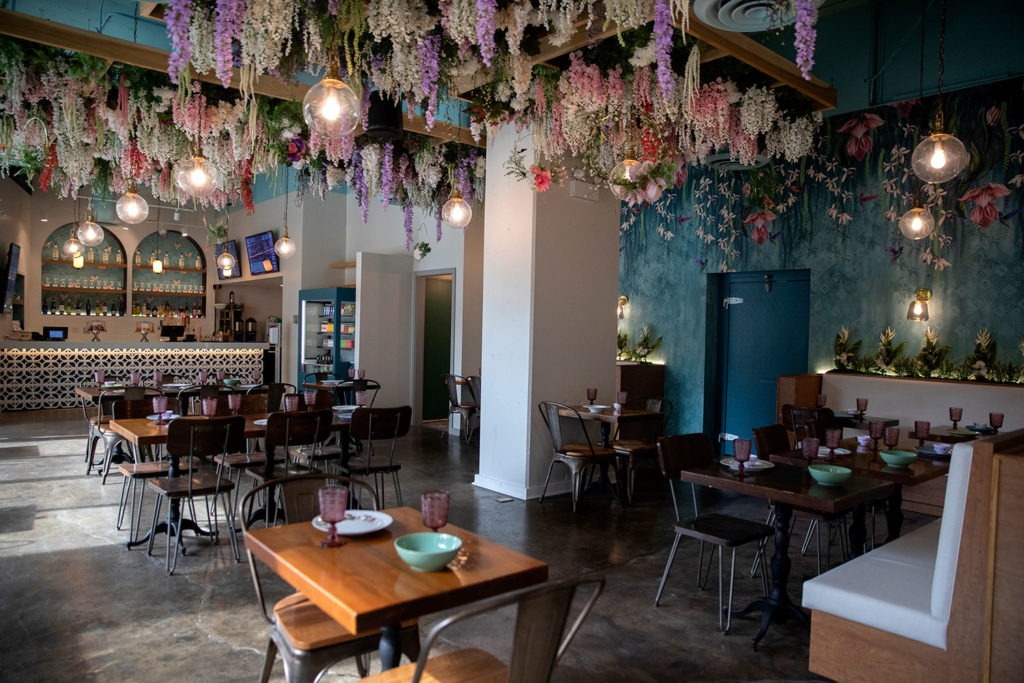
“During our busy times we have lines out the door,” explains the young man at the counter, who is wearing earrings, a choker necklace, a beanie and a droopy cardigan. “On a Thursday morning in the winter, it’s pretty empty.”
I can’t call him a waiter, because he doesn’t take my order. Instead, when I sit down, he points at a QR code on the table.
“You can scan this with your phone and then you can order and pay and we’ll bring everything out to you,” he explains.
A restaurant that only serves customers with smart phones and debit cards! That weeds out the riff raff. I order the Jorgito Bowl — tater tots and crack bacon topped with two sunny-side eggs. It’s an extra $3.50 for 25 mg of hemp extract. I skip that. While waiting for my meal, I listen to dance music over the P.A. and pose in front of the selfie mirror, which produces photos that cover a wall of the restaurant. Don’t look for mine. As a sign says, “Our printer is out of order. Send all photos via email.”
My Wake ’n Bacon breakfast is as unhealthy as anything from a greasy spoon. A huge mound of tater tots seasoned with chewy bacon is just what I need to walk in this cold weather. When I think of a diner, though, I think of a cash-only joint named Pete’s, where a waitress asks if I want ketchup, hon. Maybe I’ll find one out west. I start walking.
First, I need coffee. The first non-Starbucks shop is, appropriately for my mission, named Pedestrian, beside the Belmont Red Line. Pedestrian’s logo is the man on the “Walk” sign, but that’s not the source of its name, according to the assistant manager.
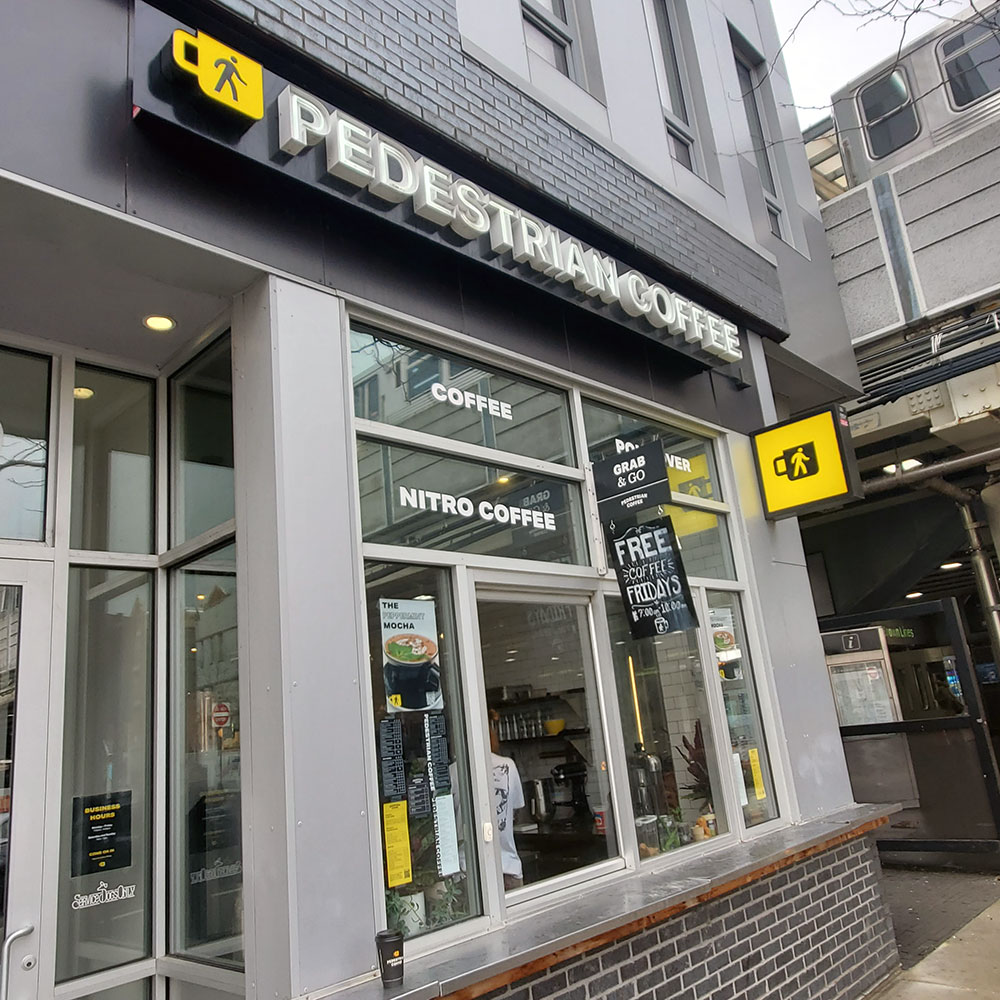
“It’s something common, something welcoming to everybody,” he says.
“Well, that’s perfect. I need some coffee for a long walk. I’m going to walk to the end of Belmont Avenue.”
“Do you want two? You’ve got two hands.”
I order one, a large, but even after I pour four packets of sugar into it, the taste is…pedestrian. The coffee lasts me until Damen, though. At Wolcott, I cross the street to retrieve a pair of hula hoops escaped from children on the playground of Jahn School of Fine Arts.
Once I cross the river, I’m in Avondale. This is the Northwest Side, where Latinos, hipsters, and Latino hipsters mingle. I see the Latino presence in signs for “Seguros Tepeyac” and “Servicios de Notaria.” I see the hipster influence at The Horror House, a scary movie memorabilia boutique. The Horror House is one of nine goth-themed businesses that recently formed the Odd in Avondale coalition — shop at one, get 10 percent off at another.
“It all started with Kuma’s Corner,” explains Horror House co-owner Vinny Malave. “Then The Alley relocated here. Then Brewed, even though it’s not on Belmont. Then you’ve got a place named Deep Red opening up — it’s a horror-themed wine bar on Milwaukee.”
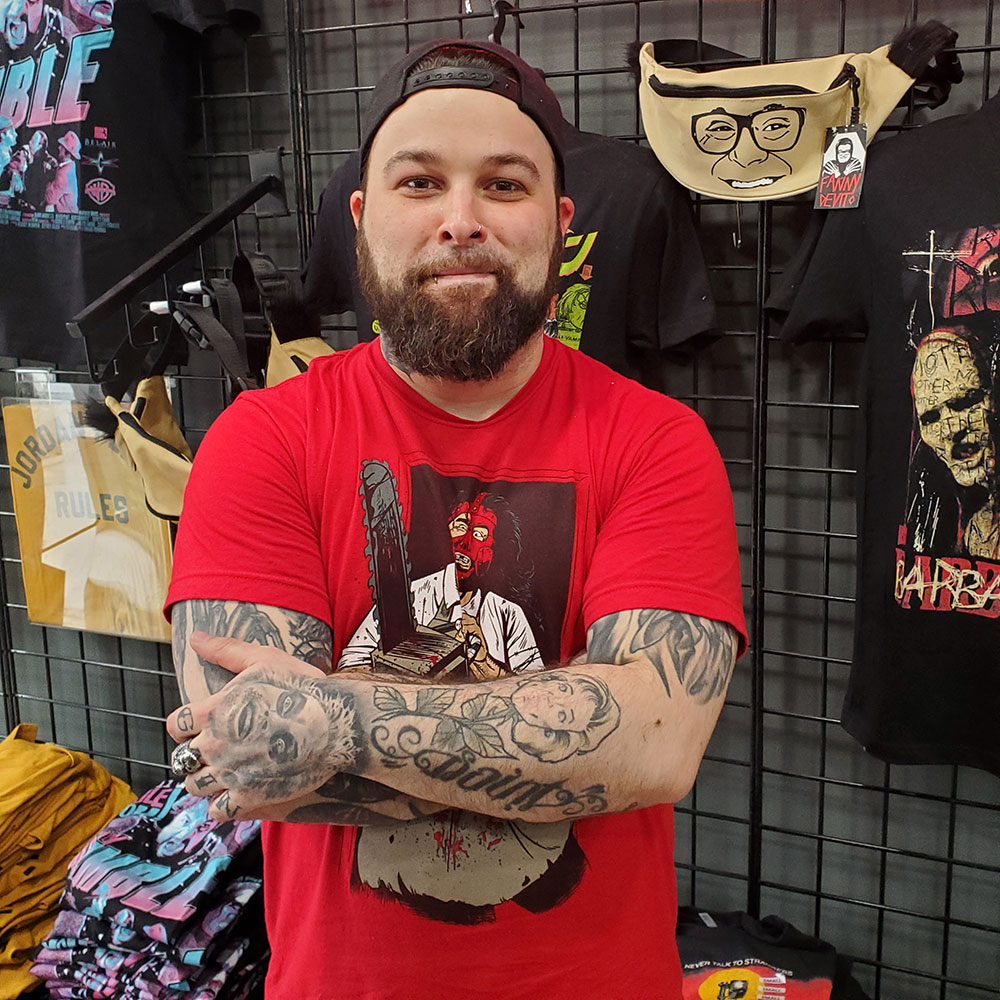
Malave is a burly, bearded man whose tattoos reflect his commercial pursuits — except one. Up and down his arms are Pennywise from It, Freddy Krueger from Nightmare on Elm Street, Patrick Bateman from American Psycho — and Betty White from The Golden Girls.
“If there’s one thing that would surprise people about me, it’s that I love The Golden Girls,” Malave says. “They were on at 9 p.m., so if I wanted to stay up late, the only way I could stay up late is to watch The Golden Girls with my mom. I got to love the show. I even sneaked them into the wraparound on the window.”
I go outside to look. Sure enough, there are the tiny faces of Bea, Betty, Rue, and Estelle, between the huge heads of Frankenstein and Leatherface.
I pass the Belmont Blue Line stop, sheltered by blue petals glowing under the wan sun. At Central Park, semi trailers are jammed against the curb. A pink “Filming Notice” sign taped to a door announces that “Minim Productions, Inc. will be filming scenes for the TV show titled Sheldrake. There is no TV show titled Sheldrake.
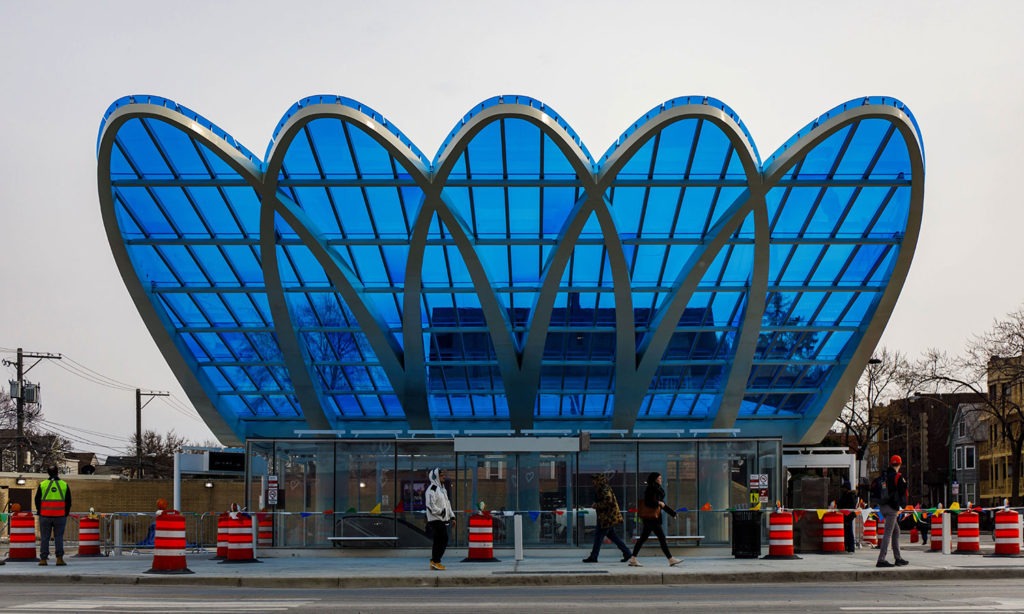
“What’s this show about?” I ask a production assistant.
“It’s The Bear,” he says.
“It says Sheldrake.”
“Maybe I’m not supposed to say that.”
I see a man wearing a jacket with the legend “The Original Beef of Chicagoland” and a Bar Bin labeled “Food Prep/Fake Ice/Fake Glass,” so the secret won’t stay secret long.
Noon is not too early for day drinking, especially since I’m nearly halfway through my walk. The Belford Tavern is a slashie on the corner of Pulaski with faded lettering and an equally faded clientele, at least at a quarter past twelve. (The name, and the bar, must date back to when Pulaski was named Crawford.) A couple old men sit at the bar drinking beer from goblets large enough to nurse through an afternoon. A Spanish-language soccer game plays above the bar.
“It’s Juventus and I don’t know,” says the bartender, in an accent that’s Greek or something like it, as he stacks cases of beer in the freezer. “The Polish guy, he like to watch, so…”
I have what they’re having, which turns out to be Miller Genuine Draft, $2.50 a pint. There’s a portrait of a grinning Al Capone behind the bar, above bottles of Canadian Club and Christian Brothers Brandy, and a few video poker machines, ignored by patrons who are only here to drink.
Just in time for lunch, I find the diner I’ve been looking for: the New Delta Family Restaurant, on Cicero, just north of Belmont, in the Belmont-Cragin neighborhood. I take a seat on a turquoise stool, at a formica counter well-stocked with salt, pepper, sugar, ketchup and tabasco sauce, and order a grilled cheese and fries, which will set me back five and a quarter. Owner Penny Revels scribbles my order on a green notepad, then heads back to the grill to prepare it herself.
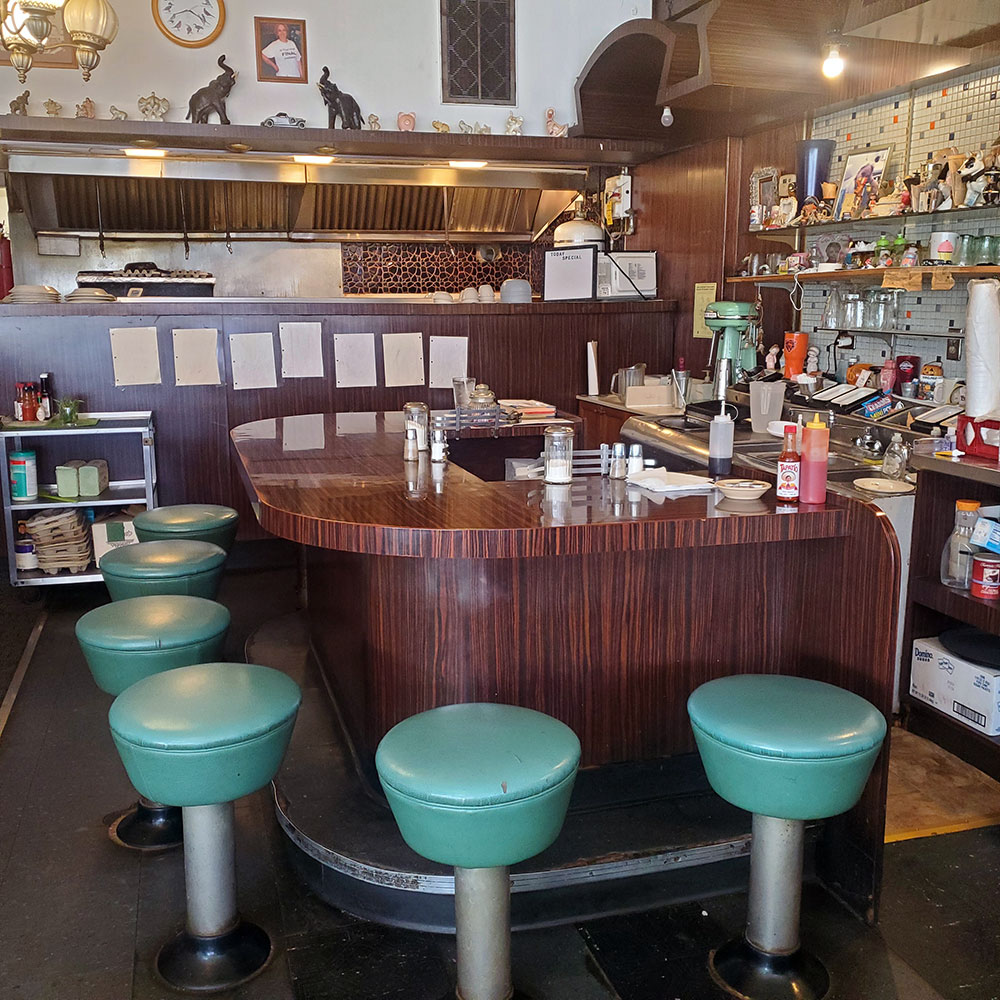
Revels inherited the New Delta from her mother Alberta, who bought it in 1982. Revels has never changed the menu, which is mostly pancakes, omelets, hamburgers and BLTs, nor has she removed her own childhood portrait or her mother’s collectible knick knacks from behind the counter.
“This place has been here since at least the 1950s,” she says. “These are places our parents would go for breakfast. All it is is a little diner. My mother used to tell me, a restaurant, they serve mashed potatoes and vegetables. A diner doesn’t. I don’t even serve dinner. You don’t see these places anymore. They’re more modernized, going with the times.”
I tell Penny about ordering my breakfast with a QR code at Wake ’n Bacon.
“I couldn’t do that,” she says. “I’m not sua-vay enough.”
The New Delta gets Sunday business from the Chicago Tabernacle, up the street, and daily business from the Hotel Elinor, across the street. The Elinor is an 80-room SRO where a sign in the window advertises single rooms for “$190 wkly, refrig-micro included,” and keys dangle from plastic fobs behind the counter.
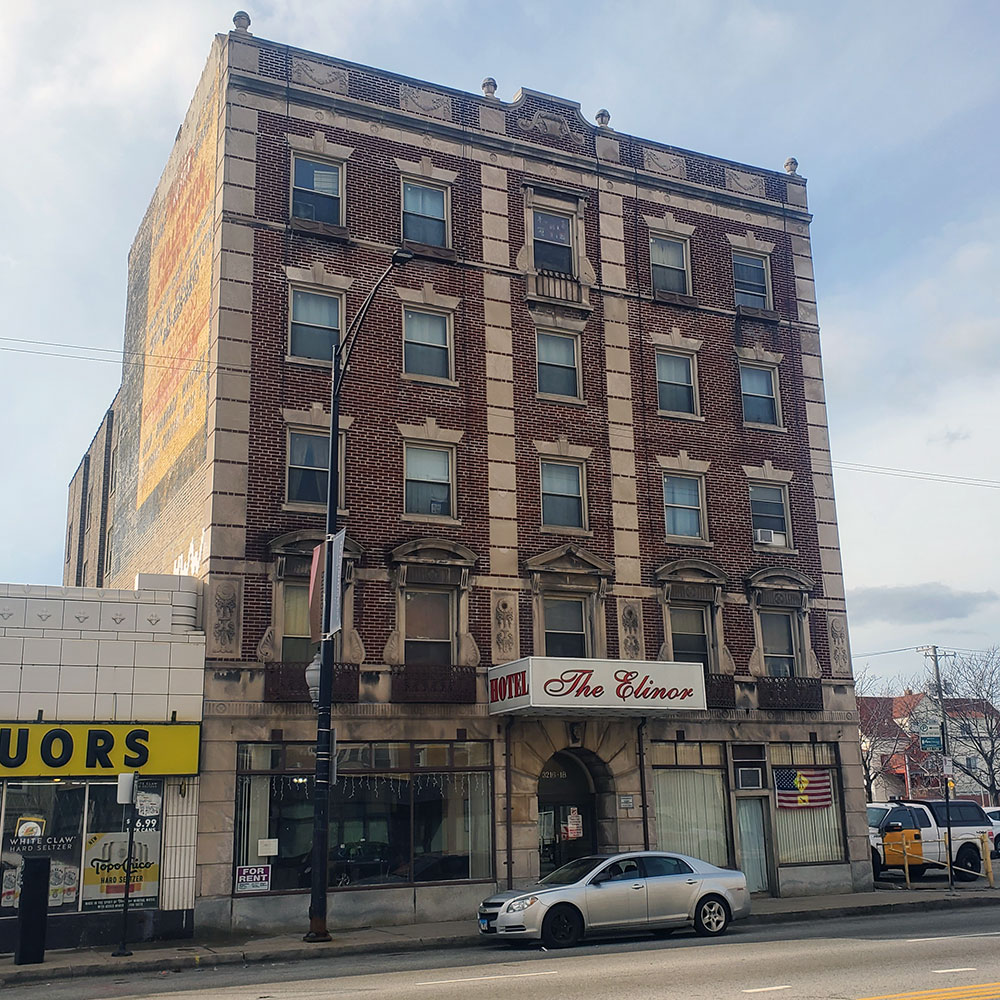
“That hotel’s probably been here a hundred years,” Revels says. “That sucker’s old. I don’t know if you’ve been in there, but from Al Capone’s day, they have those elevators with cages. I helped a guy move out of his room once, and his room was just from here to the door. Just big enough for a bed. I get a lot of nice people from over there.”
Belmont and Central was once, perhaps, the most Polish intersection in Chicago, back when Chicago was said to have more Poles than Warsaw. There are still Polish businesses here, including the restaurant with the most self-referential name in Chicago: Polish Food. Inside, three men in working clothes sit in a booth, speaking Polish.
“Why is this restaurant called Polish Food?” I ask the woman at the counter.
“It’s Tasty Polish Food.”
“Tasty Polish Food. That’s even better. Are most people who eat here Polish?”
“Yes.”
“Are most people in the neighborhood Polish?”
“No. Most people are Mexican. Years ago, most people were Polish, but they moved to the suburbs.”
“What’s the most Polish thing on the menu?”
“Knysza. It’s pocket bread.”
“Like a knish?”
“Yes. You can get it stuffed with beef or chicken.”
If you missed out on Paczki Day, as I did, there’s a second chance in Belmont-Cragin. At Wiklanski’s Bakery, in fact, there are 364 more chances.
“Every day make new paczki,” a woman tells me, fetching a raspberry from a rack in a glass case.
Paczki fortifies me for the final three miles of Belmont Avenue. It’s a cold, blustery day, and out here, there are fewer buildings to break the wind. Two flats with stone accents. One-story commercial strips occupied by attorneys, insurance agents, driving schools. I pass through Belmont Heights, then Schorsch Village, with its 92-year-old banquet hall. Belmont Terrace, where the Northwest Side convention of beginning each street name with the same letter of the alphabet reaches P: Pittsburgh, then Pontiac, where the sidewalk finally ends, at a strip of woodland beside Cumberland Avenue. Across the street, a 77 bus idles in a corral, preparing to return to the lakefront. My feet are sore. My legs are sore. My back is sore. Walking 10 miles is more exhausting than running 10 miles, because it takes so much longer. The bus feels as luxurious as a limousine, as I sit quietly in the window, watching Belmont Avenue unspool backwards, becoming more modern by the mile.



